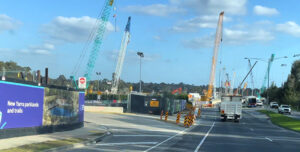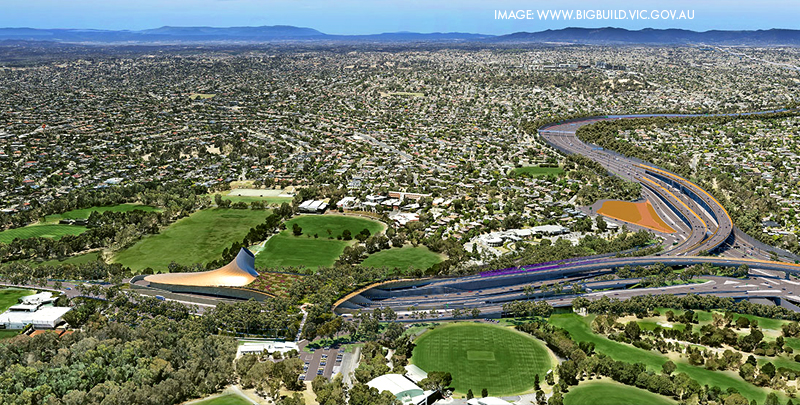The past few years, and especially the period since the COVID-19 pandemic, have seen a surge of infrastructure construction in Victoria. This ‘big build’ has sparked plenty of debate, with questions raised about its necessity and whether funds could have been better allocated elsewhere. We won’t delve into that debate, but from a property investment perspective, it is important to look at the potential impact on home values.
Victoria’s transportation infrastructure is experiencing a significant transformation, marked by major road and rail projects. These include the Metro Tunnel, North East Link, and West Gate Tunnel, along with the Suburban Rail Loop and Airport Rail links. Additionally, the ongoing Level Crossing Removal project continues to reshape the region’s connectivity.
The healthcare sector is also witnessing significant expansion, with new hospitals planned or under construction in Footscray, Cranbourne, Craigieburn, Sunbury, Phillip Island, Mernda, Diamond Creek, and further out in Torquay. Furthermore, numerous new schools are being built, and existing ones are receiving upgrades and renovations.
Infrastructure developments can be a double-edged sword, either boosting a suburb’s desirability and driving up property prices or creating disruptions and negatively impacting values.
There are many factors that contribute to a property’s value. While the physical characteristics of a property – its size, style, and condition – are crucially important, it’s the locational factors that we are most interested in when it comes to infrastructure impacts.
These locational factors include the surrounding streetscape, the mix of residential and commercial development, access to public transport and major road networks, proximity to parklands, and the availability of employment and education opportunities.

Improving connectivity
Infrastructure such as road and rail links can provide a major boost to an area’s appeal by increasing connectivity and decreasing congestion.
Developments can even have an impact on more established suburbs, which are already valued at a premium.
The Metro Tunnel project, for example, is set to enhance connectivity in the north-western and western suburbs by adding new train stations in areas currently underserved by public transport.
The new Parkville station, with its connection to the existing network through Arden Street and Footscray, will link the western suburbs to key employment hubs like Melbourne University and the hospital precinct, increasing the appeal of areas like Footscray and Yarraville. This improved accessibility can drive up property values as residents benefit from shorter commute times and greater convenience.
Looking back at past projects, the completion of CityLink around 2000 offers a prime example of how infrastructure can transform a suburb. By diverting traffic away from Kensington and Flemington, CityLink reduced congestion and noise pollution, making these suburbs more attractive. Their proximity to the city, combined with improved accessibility and period-style housing, made them a compelling alternative to pricier inner-city areas like Carlton North and Fitzroy North, leading to an increase in property values.
The North East Link is another project with the potential to significantly improve suburb appeal. By diverting traffic away from residential streets in the inner northern suburbs, it will reduce noise and pollution, benefiting areas like Heidelberg, Rosanna, Macleod, Watsonia, and Greensborough. Properties currently located near busy thoroughfares will become more desirable as concerns about noise and traffic diminish.
Boosting employment opportunities
Beyond improved connectivity and reduced congestion, infrastructure projects can also generate significant employment opportunities, further enhancing a suburb’s appeal.
The new Footscray Hospital is a prime example. The expected increase in patient capacity, of approximately 15,000 per year, will create a surge in demand for healthcare professionals, including doctors, nurses, and other specialists. Many of these individuals will need to live close to the hospital, particularly those on-call, leading to increased demand for housing in the surrounding area.
This influx of professionals can trigger a ripple effect. As they invest in their homes and renovate, it stimulates the local economy, creating more jobs for tradespeople and other service providers. The heightened demand for housing can then drive up property values, creating a positive cycle of growth and development.
The downside of infrastructure
While infrastructure projects often bring positive changes, it’s important to acknowledge that they can also be met with resistance, especially in well-established areas where residents are accustomed to the existing environment.
The level crossing removal and installation of sky rail in the south eastern suburbs is a prime example. While it has removed level crossings and improved traffic flow, the visual impact of the elevated rail line has been a contentious issue. Properties once shielded from the train line now have a clear view of it, which some residents perceive as an eyesore.
It’s also caused concerns in other areas. That was the case with the removal of the nearby stations of Surrey Hills and Mont Albert, to create the centralised Union Station. The train line was also lowered, and a road built that flowed over the top.
Concerns arose among those living near the train line, fearing they might find themselves unexpectedly close to a new station, or that their views might now be compromised. Despite these initial worries, the overall outcome has been largely positive, resulting in less noise and decreased train line visibility, and the new station is significantly more attractive than the old one.
Another potential downside of infrastructure projects is the encroachment on previously established buffer zones between residential areas and major transport routes. The North East Link project serves as a good illustration of this.
In the area of North Balwyn, the existing parkland between the Eastern Freeway and residential properties acted as a natural sound and visual barrier. The construction of the new interchange, however, has necessitated the removal of some of this parkland, bringing the freeway and its associated noise and traffic much closer to homes. This loss of buffer zones can significantly impact the appeal and value of affected properties.
Take home message
These examples highlight the importance of considering potential future developments when purchasing property. Even if a property appears to be well-buffered from existing infrastructure, future projects could still significantly alter the landscape and introduce undesirable changes.
When researching potential properties, it’s essential to be aware of planned infrastructure projects and their potential impact. While there’s no guarantee that plans won’t change, understanding the current landscape can help you make more informed decisions.
If you’re considering a property near existing infrastructure, be mindful that factors like noise, traffic, and visual impact could become more pronounced. It’s crucial to weigh these potential risks against the property’s other benefits.
As always, thorough research and due diligence are crucial when navigating investment opportunities. By staying informed, you can make more confident decisions and mitigate the risks associated with unforeseen changes, and maximise the capital growth potential.
Listen to the podcast:

